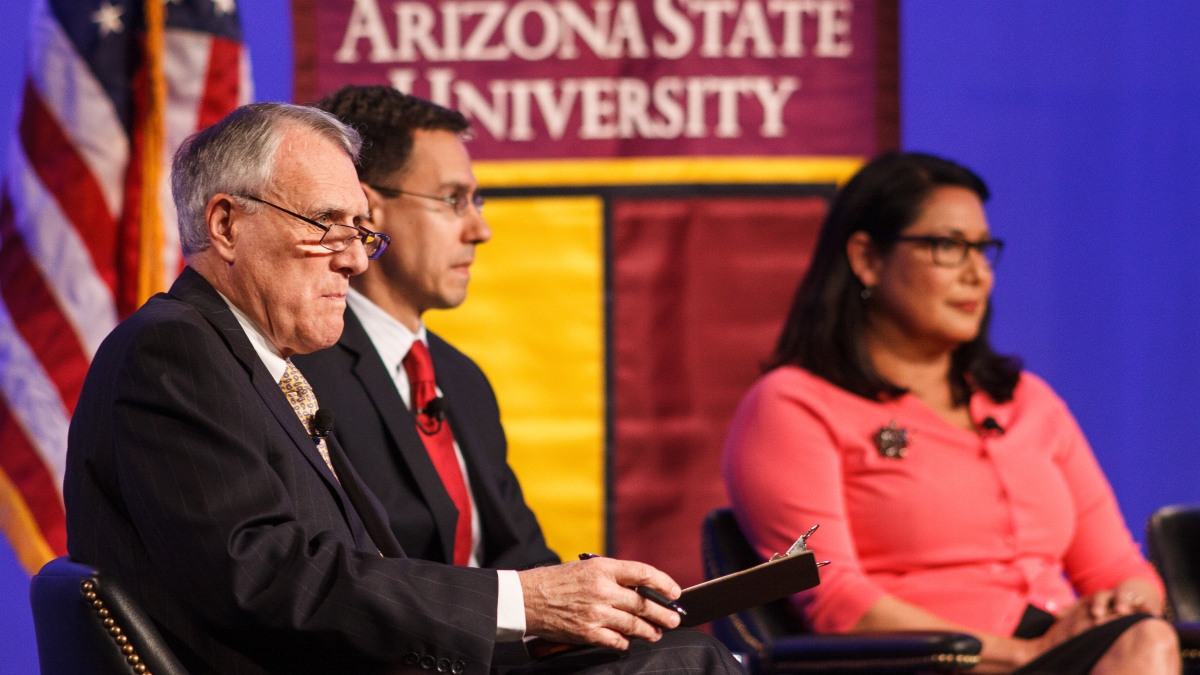ASU hosts immigration reform panel of state leaders

A live forum of Arizona business leaders, academics and public officials aimed at stimulating civil dialogue about immigration reform legislation took place April 19 on ASU’s Downtown Phoenix campus. Moderated by former Arizona Senator Jon Kyl, the six-person panel discussion aired live on ASU’s Eight, Arizona PBS digital channel 8.3 (Eight World).
“Immigration Reform: Is it time and what should it include?” was part of a combined national effort among 75 college and university presidents to focus attention on the role of immigration in driving innovation and creating American jobs – with all of them hosting discussions on their respective campuses. ASU President Michael M. Crow joined with the presidents of Cornell University and Miami Dade College last month to call on the nation’s higher education institutions to organize similar campus events all on April 19.
Crow introduced Kyl to a live studio audience and television viewers as “one of ASU’s newest scholars.” Kyl recently accepted a part-time appointment at ASU as Distinguished Fellow in Public Service in the College of Public Programs and as O’Connor Distinguished Scholar of Law and Public Service in the Sandra Day O’Connor College of Law.
The six panelists included Glenn Hamer, president and CEO, Arizona Chamber of Commerce and Industry; Tamar Jacoby, president and CEO, ImmigrationWorks, USA; Lisa Magaña, associate professor, ASU’s School of Transborder Studies; Bill Montgomery, Maricopa County Attorney; Daniel “Danny” Ortega Jr., attorney at law, Ortega Law Firm, P.C.; and Mayor Scott Smith, City of Mesa. The televised panel in its entirety may be viewed at http://www.azpbs.org/asu/immigration_reform/.
In opening the discussion, Kyl encouraged panelists to explore the issues of the pending legislation proposed by the United States Senate’s Gang of Eight and consider what they think will either promote or impede its passage.
“The presumption here is that Congress and the public believe it’s time to tackle comprehensive immigration reform,” he noted. “Our purpose here today is to understand how better it can go forward.”
Jacoby suggested that the bill offers a civics lesson in how to draft bipartisan legislation.
“The Gang of Eight did a remarkable job in finding middle ground,” she said. “But that doesn’t mean everyone will accept their compromise. The senators found the sweet spot in the middle. Now people will be trying to pull them off center.”
Jacoby added that the compromise addresses two primary political concerns – dealing with 11 million undocumented immigrants already living in the United States while at the same time securing the U.S.-Mexico border: “So 11 million will come out of the shadows and not be afraid, but they won’t get their citizenship until after 13 years because we’re still seeing if the border is secured.”
Ortega said the proposed reform closely mirrors the position taken by S.A.N.E., a broad consensus on federal immigration reform shared by 50 bipartisan organizations that make up The Real Arizona Coalition. With the exception of the provision to identify undocumented residents and provide a path to citizenship, on which S.A.N.E. does not take a position, Ortega said: “The pillars of the Senate bill and the pillars of S.A.N.E. are essentially the same.”
Kyl cited the agreement between business and labor as a major component of the proposed legislation, with half of the bill devoted to the complicated system adressing the need for guest workers in this country. He asked Hamer to speak on this issue.
Hamer praised Kyl’s past work in the Senate, noting that years of laying groundwork for comprehensive immigration reform already were completed before the Gang of Eight crafted their current plan.
“It’s a huge deal that business and labor have come together,” Hamer said. “The business community is strong behind this proposal.”
He added that the negotiations boiled down to essentially two issues: On the agricultural side, he said there’s almost universal agreement. But Hamer insisted that the numbers of workers allowed under the U.S. Senate proposal need to be higher – nearly twice what’s in the current language.
Kyl noted that Crow has emphasized the other side of visa reform designed to retain highly skilled workers in this country. The proposed immigration bill increases the number of such visas, Kyl said, while at the same time reducing so-called “lottery” visas and those granted in order to reunite families split apart by the border.
Magaña agreed that generally speaking the pending legislation would grant visas based more on an individual’s skill level than on family preference as it has in the past. “It narrows the definition, so that is a big change,” she said.
“Provisions for student visas for those doing post-graduate work, the new law would make it easier for them to get a visa,” she explained. “Also, for STEM (science, technology, engineering, math) students working on a post-grad degree, under the proposed legislation it would be much easier for them to apply.”
Mayor Smith echoed the need to retain more highly skilled workers in the United States. He also noted that while half of the 11 million undocumented immigrants came here illegally, others came legally but have overstayed their visas.
Magaña asked people to think about what it means realistically to secure the border.
“There are a lot of problems with the enforcement part,” she said. “You can’t put a triple layer wall across Arizona.”